Concept and Principles of User-Centric Design
User-centric design (UCD) has become a cornerstone in the field of business informatics, particularly for applications and information systems (IS) intended for direct end-user interaction and competitive market applications. As digital experiences increasingly influence user satisfaction and loyalty, UCD emphasizes designing solutions tailored to the users' needs, improving efficiency, satisfaction, and productivity. This approach is especially relevant for web-based IS and market applications, where user satisfaction and ease of use directly impact business success.
UCD focuses on understanding and fulfilling the needs, preferences, and limitations of end-users throughout the development process. The shift from system-centric to user-centric design is driven by the need to enhance user experience, ensuring that products are not only functional but also intuitive and enjoyable to use (Figure 1).

As information systems become more complex, UCD ensures these systems remain accessible and effective. By centering the design process around the end-user, businesses can create more intuitive and enjoyable experiences, leading to higher adoption rates and customer satisfaction. The iterative nature of UCD involves constant feedback and improvement, ensuring that products are continuously refined to meet evolving user needs.
UCD is not just a luxury but a fundamental business requirement. Studies show that 88% of online consumers are unlikely to revisit a website following a negative experience [1]. Additionally, 75% of users acknowledge that they form opinions about a company's trustworthiness based on its website design [2]. These statistics highlight the substantial influence that UX/UI design can exert on user attitudes and, by extension, business results.
User-centric design is a systematic approach that places the needs, preferences, and limitations of end-users at the center of every stage of design and development (Figure 2) [3][4]. The process begins with research, where business analysts and designers gather insights into user behaviors, motivations, and pain points through methods like interviews and surveys. This phase ensures a deep understanding of user needs.

Next is analysis, where the gathered data is synthesized to identify patterns, user personas, and user journeys, forming the foundation for design decisions. Ideation follows, where creative design solutions are brainstormed based on the insights gained, and prototyping transforms these ideas into tangible forms, ranging from low-fidelity sketches to interactive mock-ups for testing.
Testing involves gathering user feedback to evaluate how well the prototype meets user needs, identifying any usability issues. The refinement phase incorporates this feedback to make iterative improvements. Once the design is finalized, it moves to implementation, where the design is developed into a functional product. Continuous evaluation checks the success of the design using metrics like user satisfaction and task completion.
Finally, UCD is an iterative process, with ongoing cycles of feedback and adaptation to ensure the product evolves in response to changing user needs and market conditions.
Key principles of UCD include usability, accessibility, response to action, feedback and interaction, simplicity, and consistency [5][6]. Usability guarantees the product is easy to use. This involves simplifying interfaces, reducing the number of steps required to complete tasks, and ensuring that users can achieve their goals with minimal effort. In the FinTrack application example, conducting usability testing with real users to refine the interface can ensure that tasks like budgeting and expense tracking are straightforward and understandable for users.
Accessibility & Inclusivity focuses on making sure that the product is accessible to all users, including those with disabilities. This involves considerations such as screen reader compatibility, keyboard navigation, and color contrast. Implementing features like voice control and high-contrast modes to accommodate users with disabilities can ensure FinTrack is inclusive.
Response to action aims at providing users with immediate responses to their actions while using the product. For FinTrack, this principle can be realized by incorporating instant feedback mechanisms, such as notifications and progress bars, to inform users of their actions' outcomes, such as a successful budget update.
Feedback & Iteration centers around encouraging and facilitating clear and constant feedback from users. This helps improve the product based on user opinion. User research can help FinTrack reveal qualitative and quantitative data about user behaviors, needs, pain points, and motivations. For example, one of the research results may be about the issue that many users struggled with linking multiple bank accounts. This insight may lead to the development of a streamlined, step-by-step account linking process, enhancing user satisfaction and reducing drop-off rates.
Simplicity means reducing complexity to enhance understanding and ensure straightforward use. This involves removing unnecessary features and focusing on core functionalities. Designing FinTrack's interface with clear labels, intuitive navigation, and a clean layout can prevent users from feeling overwhelmed.
Consistency guarantees design elements are consistent throughout the product. This helps users build familiarity and predictability, making the product easier to navigate. The main goal of the designers and business analysts of FinTrack is to make sure all elements, like buttons and menus, are consistent in design and functionality across different sections of FinTrack to enhance predictability and ease of use.
In essence, UCD is a cyclical and iterative process that places users at the center of design decisions, ensuring that products are intuitive, efficient, and aligned with user expectations and business objectives.
Benefits and Challenges of UCD
According to a report by McKinsey & Company [8], there is a correlation between the financial performance of 300 companies and their internal focus on UCD. The report suggests that companies should view this relationship from a strategic perspective.
1. Advantages of UCD
Integrating UCD into business analysis yields numerous benefits, enhancing both the user experience and the business outcomes [9]:
- Enhanced user satisfaction and loyalty: By focusing on user needs and preferences, businesses can create products and services that are more satisfying and enjoyable to use. UCD ensures that the end product aligns with user expectations, leading to higher satisfaction levels. Satisfied users are more likely to become loyal customers, promoting positive word-of-mouth and repeat business. For example, a well-designed mobile banking app that is easy to navigate and meets user needs can lead to increased user retention and loyalty.
- Reduced development costs and time: Early and continuous user feedback helps in identifying and addressing issues before they become costly to fix. Prototyping and usability testing allow business analysts to catch usability issues early in the development process, reducing the need for extensive rework. This approach minimizes waste, streamlines development efforts, and shortens time-to-market. For instance, identifying and correcting a confusing navigation flow during the prototyping phase can prevent expensive changes during the final stages of development.
- Increased conversion rates and revenue: Optimizing the user experience directly impacts conversion rates and overall revenue. UCD focuses on making it easy and intuitive for users to achieve their goals, whether it's completing a purchase, signing up for a service, or using a feature. This focus leads to higher conversion rates. For example, an e-commerce site that simplifies the checkout process through user-centric design principles can reduce cart abandonment and increase sales.
- Higher user engagement: Products designed with the user in mind tend to engage users more effectively. Engaging designs that consider user behaviors, preferences, and motivations encourage users to spend more time interacting with the product. This can result in increased usage frequency and deeper engagement. For example, a social media platform designed with user-centric features like personalized content feeds and intuitive interaction mechanisms can significantly boost user engagement.
- Better alignment with market needs: UCD ensures that products are closely aligned with current market demands and trends. Continuous user research and feedback collection keep the business informed about evolving user needs and preferences. This alignment helps in staying competitive and relevant in the market. For instance, incorporating user feedback into the development of a new software feature can ensure it meets current market needs and outperforms competitor offerings.
- Improved accessibility and inclusivity: Designing for accessibility ensures that products are usable by a wider range of users, including those with disabilities. By adhering to accessibility standards and involving users with disabilities in the design process, businesses can create more inclusive products. This not only expands the potential user base but also demonstrates corporate social responsibility. For example, an accessible website that provides features like screen reader support and keyboard navigation can serve a broader audience, including visually impaired users.
- Informed decision-making: Data-driven insights from user-centric design processes inform strategic business decisions. User research and usability testing provide valuable data that can guide product development, marketing strategies, and business planning. These insights help in making informed decisions that are more likely to succeed in the market. For instance, analyzing user feedback and behavior data can inform decisions about which features to prioritize in the next software release.
- Enhanced brand reputation: A commitment to UCD enhances the brand’s reputation as user-friendly and customer-focused. When users consistently have positive experiences with a brand’s products, it strengthens the brand’s reputation. This positive perception can differentiate the brand in a crowded marketplace. For example, a technology company known for its intuitive and user-friendly software can build a strong brand reputation that attracts and retains customers.
2. Challenges of UCD
While the benefits of UCD in business analysis are clear, implementing these principles can pose certain challenges [10]:
- Implementing UCD can be resource-intensive, requiring significant time and effort for user research and testing. To address this, UCD practices can be integrated into the project lifecycle, and lightweight, iterative methods such as lean UX can be employed to reduce resource consumption.
- User requirements can sometimes conflict with the requirements of other stakeholders, such as business owners, developers, or compliance teams. Balancing these differing priorities is challenging, and it is not always the case that user needs are prioritized above all else. Prioritizing features based on user feedback and business impact, using methods like the Kano model to categorize features by their ability to delight users and their importance to business objectives, helps in managing this challenge. Weighted scoring can be useful when balancing requirements with competing priorities. By assigning weighted scores to features based on factors like business value, user need, and technical feasibility, business analysts can objectively identify the features that provide the most balanced value to both users and stakeholders.
- Resistance to new approaches from stakeholders is another issue. Educating stakeholders on the benefits of UCD through workshops and pilot projects that demonstrate tangible improvements, as well as conducting training sessions, can help overcome this resistance.
- Resource constraints make comprehensive user research and usability testing difficult. Focusing on key areas that will have the most significant impact on UX and leveraging online tools for remote usability testing can optimize resource allocation and reduce costs.
- Users may have diverse and conflicting needs. Addressing this challenge involves prioritizing features based on user research and feedback, ensuring that the most critical needs are addressed first.
- Balancing user needs with technical constraints presents another difficulty. Engaging cross-functional teams early in the process helps find feasible solutions that satisfy user requirements while respecting technical limitations.
Overall, the integration of user-centric design principles into business analysis transforms the way solutions are conceptualized and developed. This user-focused approach ensures that every stage of the development process, from requirements elicitation to solution validation, is aligned with real user needs, leading to higher user satisfaction and better business outcomes.
3. Who benefits most from a UCD approach?
While UCD can enhance the development of most software solutions, certain types of systems particularly benefit from this approach due to their complexity, user interaction level, and the critical need for intuitive design. Software that involves regular user engagement, such as customer-facing applications, financial tools, healthcare platforms, and educational software, often requires UCD to be highly successful.
For example, customer-facing applications such as banking apps or e-commerce platforms rely heavily on user satisfaction and ease of use, which are essential to retain customers and drive sales. Likewise, financial management tools like the hypothetical “FinTrack” presented in this article are prime candidates for UCD implementation. Financial tools deal with complex data and decision-making processes, where users need clarity, efficiency, and simplicity to navigate financial planning, budgeting, and investments.
In healthcare systems, where users often include both patients and professionals, intuitive interfaces and smooth workflows can significantly impact the user’s ability to access or deliver care. Similarly, educational software that facilitates learning processes or skill-building benefits from UCD by providing interfaces that are easy for students and educators to navigate, ensuring an accessible learning experience.
In all these systems, the UCD approach ensures that features are designed in response to actual user needs. For FinTrack, the inclusion of real-time tracking, personalized dashboards, and clear financial reporting were directly informed by user personas and journey maps. By understanding how users engage with these complex systems and regularly testing for usability, UCD ensures that the final product is both functional and highly user-friendly.
Practical applications of UCD in business analysis
Following the UCD process, a lot of business analysis activities can be significantly improved. The main areas of business analysis that can be enhanced with UCD are presented in Figure 3.
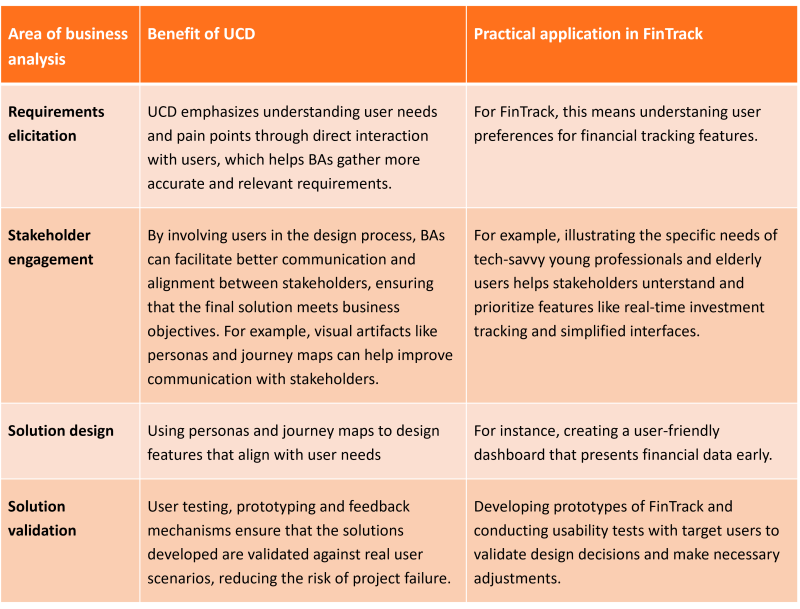
Implementing UCD effectively involves several strategic steps that ensure the end product aligns closely with user needs and expectations. Three key strategies for implementation include creating user personas, journey mapping, and conducting usability testing [7].
User personas are fictional characters created based on user research to represent user types that might use a service, product, site, or brand. To create detailed user personas, it is advised to start by collecting data through user interviews, surveys, and market research. This data should include demographics, user behaviours, goals, motivations, and pain points. The personas should be detailed and based on actual user data, ensuring that they accurately represent the user base.
Creating user personas involves synthesizing this data into coherent profiles that include a name, age, job role, interests, and specific pain points. This step helps to humanize the data and makes it easier for design teams and business stakeholders to empathize with the end users. Practical hints include regularly updating personas as new data is gathered and using them actively in design discussions to ensure that decisions are user-focused.
For FinTrack, a financial management tool designed to assist users with personal finance management, personas were created to represent three main user types: a tech-savvy young professional managing student loans and investments (Figure 4), a middle-aged user planning for retirement (Figure 5), and an elderly user managing pensions and daily expenses (Figure 6). These personas helped identify specific needs and preferences, such as the young professional's requirement for real-time investment tracking, the middle-aged user's need for retirement planning tools, and the elderly user's need for a simplified, high-contrast interface.
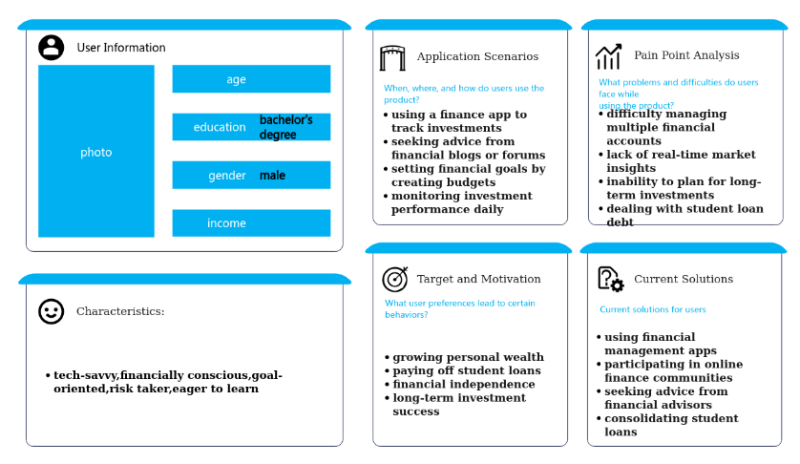
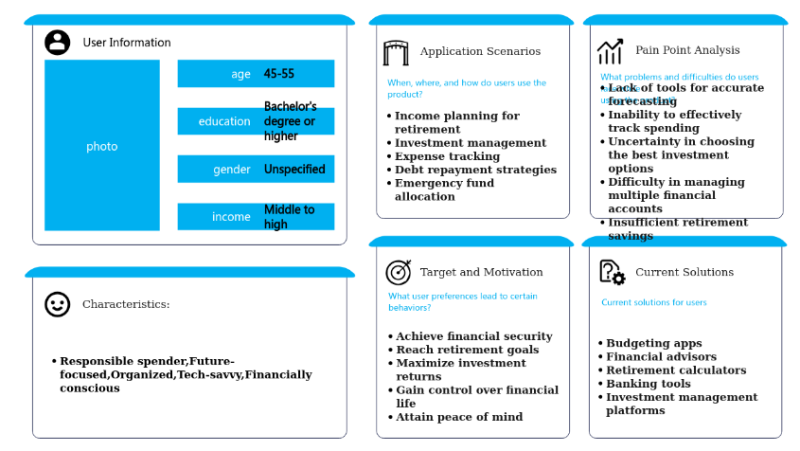
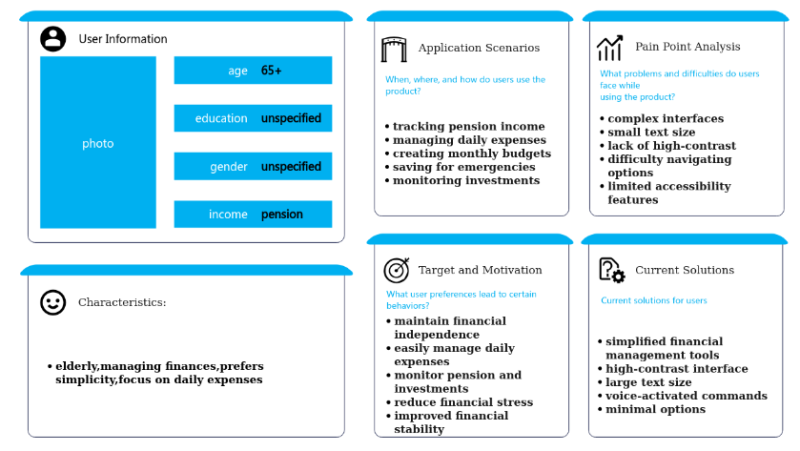
Journey mapping involves visualizing the process that a user goes through to achieve a specific goal with a product or service. This can highlight pain points and areas where the user experience can be improved. It is advised to begin with identifying the key stages in the user's interaction with the product, from initial awareness to the final goal. For each stage, the user's actions, thoughts, and feelings should be documented. Visual tools such as flowcharts, diagrams, and storyboards can help illustrate the journey. Engaging stakeholders in workshops to collaboratively create these maps can also provide deeper insights and foster alignment.
By mapping the user journey, key stages such as initial account setup, linking bank accounts, setting financial goals, and monitoring expenses were identified (Figure 7). Each stage was analyzed for user actions, thoughts, and feelings. For example, during the account setup stage, users expressed confusion about linking multiple accounts. To address this, the setup flow was redesigned to include step-by-step guidance and visual cues, significantly improving the user onboarding experience.

Usability testing involves evaluating a product by testing it on real users to identify usability issues before the product goes live. The process begins with developing a test plan that outlines the objectives, target users, tasks, and success criteria. Following this, test scenarios that mimic real-life situations users might encounter are created. During the test, observations are made on how users interact with the product, noting any difficulties or confusion. Practical recommendations include conducting both moderated and unmoderated tests, using tools such as screen recording software, and employing both quantitative metrics (like task completion rates) and qualitative insights (like user feedback). Regularly scheduled usability tests throughout the development process ensure continuous improvement and validation of design decisions.
In the FinTrack example, usability tests were conducted in which users were asked to perform tasks such as creating a budget, categorizing expenses, and generating financial reports (Figure 8). Observing these sessions identified areas of confusion, such as difficulty navigating the expense categorization feature. By making the interface more intuitive and providing clearer labels and tooltips, improvements in task success rates and reductions in user frustration were achieved.
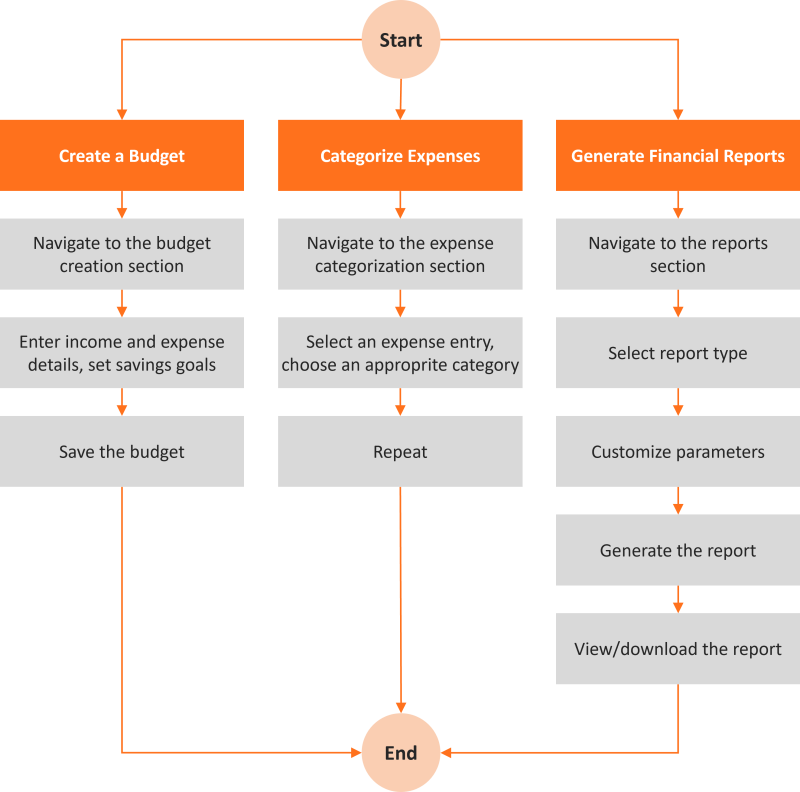
In developing FinTrack, UCD principles play a pivotal role in conducting business analysis (Figure 9).
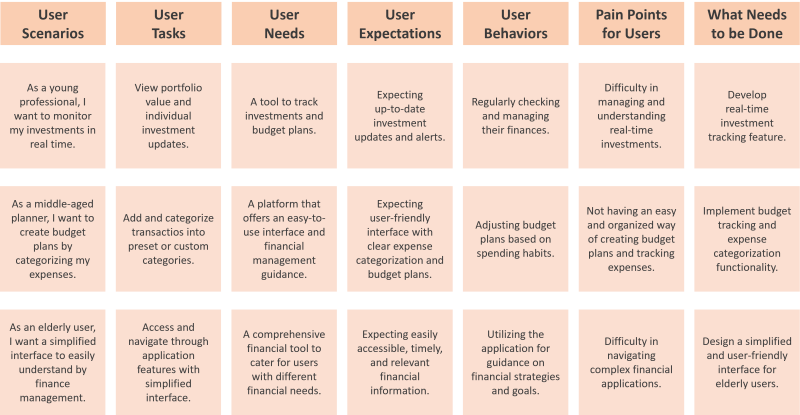
This approach begins with the creation of detailed user personas, representing diverse demographics like young professionals, middle-aged planners, and elderly users. By empathizing with these personas, the design team identifies specific needs such as real-time investment tracking for young professionals and simplified interfaces for elderly users. Throughout the design process, continuous user involvement is ensured through initial surveys and interviews to gather insights into users' financial habits, needs, and pain points. These inputs inform the development of intuitive features like budget tracking, expense categorization, and financial goal setting, aligning closely with actual user requirements and enhancing overall user experience.
Conclusion
User-centric design is essential for creating effective and satisfying digital solutions. By focusing on the user’s needs and continuously refining the design, developers can enhance user experience, drive engagement, and achieve better outcomes. The principles of usability, accessibility, feedback, simplicity, and consistency are fundamental to this approach. Practical strategies like creating user personas, journey mapping, and conducting usability testing ensure that the design process remains user-focused.
The integration of UCD into business analysis provides substantial benefits, from increased user satisfaction and loyalty to reduced development costs and enhanced brand reputation. By prioritizing user needs and feedback throughout the design and development process, developers can create products that not only meet market demands but also deliver superior user experiences, ultimately driving business success and growth.
Adopting user-centric design principles requires commitment, but it yields significant rewards. Developers should prioritize understanding their users, involve them in the design process, and leverage modern tools and techniques to create exceptional user experiences.
While user-centric design has proven benefits, there are, as always, areas for continuous improvement and further research. These include:
- Impact on business metrics:
conducting additional research on the direct impact of UCD on key business metrics such as revenue, market share, and customer loyalty. - Longitudinal studies:
performing long-term studies to understand the sustained impact of UCD on user behavior and satisfaction over time. - Cross-cultural usability:
investigating how UCD principles can be adapted to different cultural contexts to ensure global applicability and effectiveness.
By addressing these areas, businesses can continue to further strengthen and improve their approaches to UCD and unlock even greater value from their digital solutions.
References
- [1] Joe Rinaldi - 30 Eye-Opening User Experience Stats, 2017: impactplus.com/blog/user-experience-stats-infographic Last access: 20.07.2024.
- [2] James Griffin - Mastering the Art of User-Centric Web Design: A UX/UI Guide, 2024: linkedin.com/pulse/mastering-art-user-centric-web-design-uxui-guide-james-griffin-geaoe. Last access: 20.07.2024.
- [3] The Business Analyst - The Psychology of User-Centered Design: Enhancing User Experience in Business Analysis, 2023: linkedin.com/pulse/psychology-user-centered-design-enhancing-user-experience. Last access: 10.07.2024.
- [4] Muhammad Owais - User-Centric Approach vs. Traditional Approach in Development and Strategy: A Data-Driven Perspective, 2023: linkedin.com/pulse/user-centric-approach-vs-traditional-development-strategy-owais. Last access: 10.07.2024.
- [5] MoldStud - The importance of user experience design in business analysis, 2024: moldstud.com/articles/p-the-importance-of-user-experience-design-in-business-analysis. Last access: 10.07.2024.
- [6] UXCam - User-Centered Design - Definition, Benefits & Methods, 2024: uxcam.com/blog/understanding-user-centered-design. Last access: 12.07.2024.
- [7] The BA Guide - How Business Analysis Creates Valuable Customer Experiences: Part 2: thebaguide.com/blog/how-business-analysis-creates-valuable-customer-experiences-part-2. Last access: 21.07.2024.
- [8] McKinsey & Company - The Business Value of Design, 2018: mckinsey.com/capabilities/mckinsey-design/our-insights/the-business-value-of-design. Last access: 21.07.2024.
- [9] Enlighten Designs Blog - Top 9 Benefits of User-Centred Design, 2020: enlighten.co.nz/blog/top-9-benefits-of-user-centred-design. Last access: 21.07.2024.
- [10] LinkedIn - What challenges do developers face when using user-centered design methods: linkedin.com/advice/1/what-challenges-do-developers-face-when-using-lb0lf. Last access: 21.07.2024.





































































































































